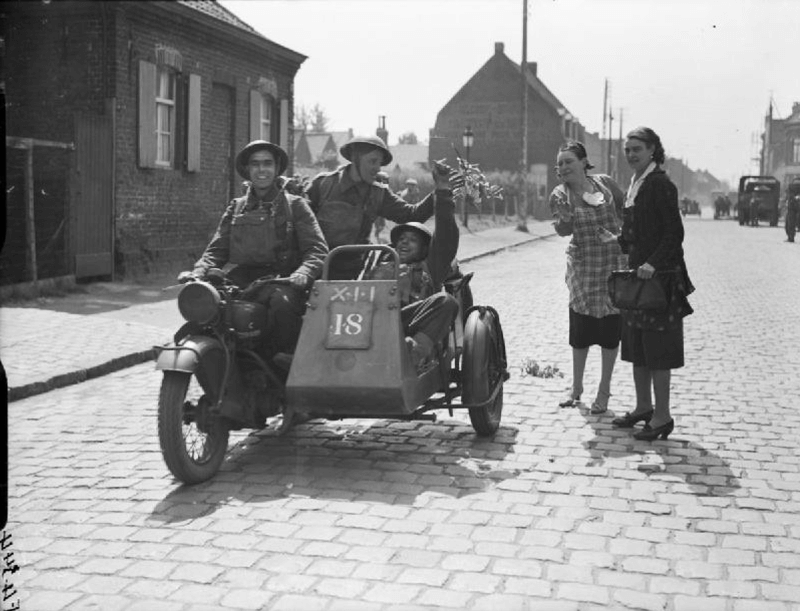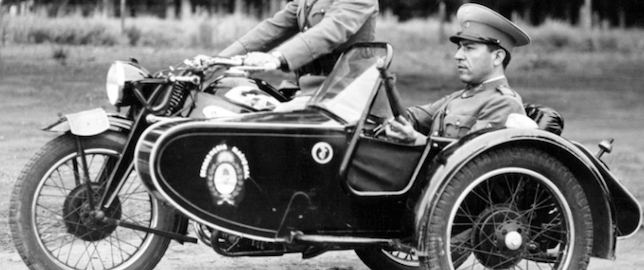Can you remember the last time you saw a rider with a sidecar attached to their motorbike? Sidecars might seem like a rare sight on the road, but they are still popular among some riders. Often referred to as a chair or hack, the sidecar has a rich history that we will explore in depth.
Humble beginnings
The most accepted story of the sidecar’s invention is that it was created in 1893 for a French newspaper competition. The aim of the competition was to find the best way to carry a passenger on a bicycle and a French army officer called M. Bertoux came up with the winning design. The sidecar was supported by a mass of tubes from the bicycle, while the seat was mounted above the crossmember with a footboard beneath it.
As motorbikes became popular, it was only natural that sidecars would be developed alongside them. In 1903, a sidecar cartoon appeared in an issue of the British newspaper Motor Cycling. In the same year, a provisional patent was given to W.J Graham in Enfield. He partnered with Jonathan A Kahn and production began immediately.
In the years before World War 1, various companies developed their own sidecar models. These include Triumph, Frera, Harley-Davidson, Peugeot, Thor and Watsonian.
Watsonian can be considered one of the earliest sidecar manufacturers. Founded in 1912 by Fred Watson, the company still makes a range of sidecars.
1913 saw an improvement in the way sidecars were built. American inventor Hugo Young designed a new sidecar that wasn’t rigidly fixed to a motorbike. The design was flexible, which meant the sidecar could turn without affecting the balance of the bike. This allowed for a safer experience for the rider and passenger. Inspired by his success, Young founded the Flxible Sidecar Company in Ohio and became the largest sidecar manufacturer in the world.

Sidecars during WW1
During The Great War, sidecars proved to be useful for the British Army. They wanted to increase the mobility of their Vickers machine guns, which weighed between 29 to 36kg. Due to the weight, each gun needed six to eight men to carry it.
To address this problem, guns were mounted to sidecar motorbikes. This allowed the guns to be moved quickly and target retreating enemy troops. The first motorbikes to be used were manufactured by Clyno, as they could carry a gun, tripod, ammunition boxes and spare parts. A special unit called the Motor Machine Gun Service was formed to operate the bikes, but the nature of trench warfare meant they weren’t used often.

Post WW1 and beyond
After the war, sidecars became less common, but there was still a place for them. A notable company founded during this period was the Swallow Sidecar Company. The manufacturer went on to become Jaguar Cars. It’s possible the Depression helped the industry because a sidecar was usually the cheapest way to get around.
Sidecars were used during WW2 by German troops, who operated BMW and Zundapp motorbikes. Decline and transition into TV
By the 1950s, the public had a wealth of cheap cars to choose from, such as the VW. As a practical unit, the sidecar couldn’t compete and the industry declined. However, with the emergence of TV, sidecars found a place in shows and films.
For example, a sidecar was used in the British 70s sitcom On The Buses. The sitcom revolved around the antics of bus driver Stan Butler and his friend Jack Harper, played respectively by Reg Varney and Bob Grant.
The sidecar motorcycle used in the show belonged to Stan’s brother-in-law, Arthur. It appeared twice in the series and had a larger role in the three films that were produced. The sidecar had a wobbly quality that made it fall apart easily, adding to the comedy of the show.
Another sitcom that featured sidecars was Last of the Summer Wine. Focusing on the misadventures of three old men, the series proved to be an instant hit with audiences. The original trio consisted of William ‘Compo’ Simmonite, Norman Clegg and Cyril Blamire.
Throughout the series, a sidecar appeared in three episodes, entitled ‘Northern Flying Circus,’ ‘The Ice-Cream Man Cometh’ and ‘A Sidecar Named Desire.’ The first episode involved the trio buying the motorbike and sidecar that belonged to an old friend. Disaster strikes and one of the men tumble off the bike. The second episode featured Compo falling off the bike and rolling down a hill.
‘A Sidecar Named Desire,’ involved Compo giving a ride to a woman called Nora Batty. In classic Summer Wine fashion, Compo loses control of the bike and rolls down a country road.
Although they might not be as popular as they used to be, sidecars are an important part of motorcycle history. For anyone who’s interested in purchasing a sidecar motorbike, there are manufacturers who specialise in designing them. They include Watsonian, Liberty and Steib sidecars.



